Abridged Series as Derivative Media
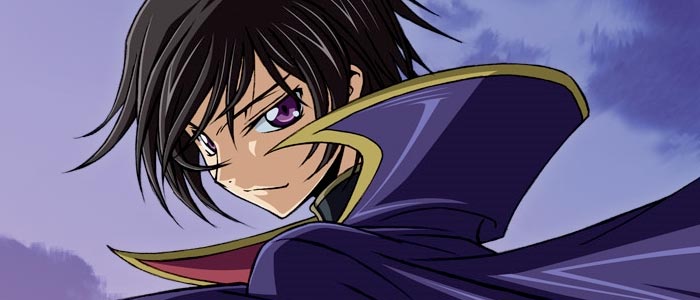
Out of all the derivative art forms to come out of the anime fandom, abridged series is one of the most interesting. Standing somewhere between AMVs (Anime Music Videos) and fandubs, abridged series are edited and dubbed parody versions of a given anime series. In his article “Abridged Series: A Short History“, ericg presents an introductory overview of the medium and its history. 1 Using it as a jumping-off point, this article aims to closer examine how abridged series may operate as derivative works. In what ways do they derivate? Where do the derivations situate them in relation to the original?
These questions will be answered by examining three forms of derivation, each through a specific work that exemplarily demonstrates the respective form. The first form is subversion, which will be examined through Little Kuriboh’s Yu Gi Oh! The Abridged Series. The second form is diversion, which will be examined though PurpleEyesWTF’s Code MENT. The third form is mashup, which will be examined through the two videos “Pirates and/or Ninjas” and “None Piece Episode 5 thru 7”, also by PurpleEyesWTF.
Subversion: Yu Gi Oh! The Abridged Series
The series that is largely considered to be the pioneer of the medium has parodic meta-commentary as its main form of derivation. As ericg notes, Yu Gi Oh! The Abridged Series (YGO:TAS going forward) primarily sets out to mock its source material, thus following the original storyline closely and “only differentiating when the characters make reference to the flaws plaguing the plot.” 2 This fact is very evident as early as the first episode. For example, Kaiba’s very first line points out both the farfetchedness of his deduction of what Yugi just had said, and his character trait as an extremely wealthy kid: “Rare card? That sounds vague enough to be the Blue-Eyes White Dragon. And since I’m a child billionaire in charge of a huge gaming company, I obviously have nothing better to do than go check it out.” Other examples from the episode include Yugi’s grandfather pointing out the ridiculous amount of dramatic gravity put into the series’ card game – “For some reason playing a card game has caused me to become severely injured.” – and Kaiba’s little brother pointing out the peripheral status of his character – “Big brother, is it time for my cameo yet?” 3
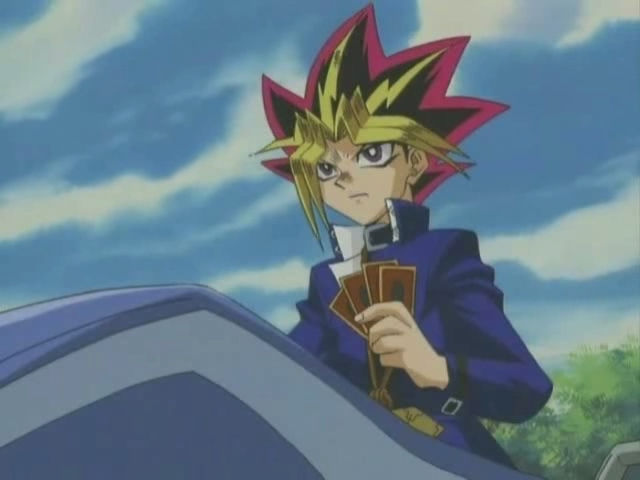 As is made evident from these examples, the series’ subversion is very blatant. It doesn’t just call attention to the flaws of the original through narrative means, but directly states them. Its derivation is thus rooted in an explicit metatext, that pulls the viewer’s experience away from the internal narrative layer to the external meta-layer; the context is the content. At times, Little Kuriboh takes this metatext even further by incorporating non-diegetic commentaries by himself. The first time this occurs is in episode three, when Tristan out of the blue says that the sun is about to rise, upon which a title card appears that says “(seriously, he actually says that… wtf?)” 4 The same type of title-card-commentary can then be seen in several later episodes, of which the one in episode seven expands it to yet another level. It starts with Kaiba using the line “You don’t stand the ghost of a chance!” one too many times, making Yugi comment on its redundancy. This is followed by a title card saying “[honestly, they use that pun way too much. here, I’ll prove it…]”, which is then followed by a montage of all the times the pun is used in the original. 5
As is made evident from these examples, the series’ subversion is very blatant. It doesn’t just call attention to the flaws of the original through narrative means, but directly states them. Its derivation is thus rooted in an explicit metatext, that pulls the viewer’s experience away from the internal narrative layer to the external meta-layer; the context is the content. At times, Little Kuriboh takes this metatext even further by incorporating non-diegetic commentaries by himself. The first time this occurs is in episode three, when Tristan out of the blue says that the sun is about to rise, upon which a title card appears that says “(seriously, he actually says that… wtf?)” 4 The same type of title-card-commentary can then be seen in several later episodes, of which the one in episode seven expands it to yet another level. It starts with Kaiba using the line “You don’t stand the ghost of a chance!” one too many times, making Yugi comment on its redundancy. This is followed by a title card saying “[honestly, they use that pun way too much. here, I’ll prove it…]”, which is then followed by a montage of all the times the pun is used in the original. 5
Even from a narratively technical standpoint it is very apparent that the metatext is vastly prioritized over the basic narrative text. Due to the comprised editing of the original, a lot of the plot continuity is diminished. The continuity of the metatext on the other hand is highly prominent. Several character traits that start off as single jokes quickly evolve into running gags whenever the respective characters are onscreen. Kaiba is a rich kid with a tense attitude and a big ego, Pegasus is a gay pedophile, and one recurring henchman of Pegasus has a really weird haircut that gets pointed out every time he appears.
This metatextuality indicates a very immediate relation to the original. As the derivation is rooted in the referential metatext, it doesn’t simply present a variation on the original, but a variation that concretely connects itself to the original. The viewer’s experience of the meta-layer therefore also includes an experience of this very connection. As such, a certain degree of familiarity with the original is required of the viewer to understand and appreciate the substance of the derivation.
Diversion: Code MENT
Whereas YGO:TAS‘ derivation is rooted in subversive mockery of the original, the derivation of Code MENT is rooted in diverting from the original. ericg writes that PurpleEyesWTF’s basic idea for the series was to reinvent the at the time iconic protagonist Lelouch vi Britannia into an idiot. To make such a radical alteration of such a central character would consequently require the whole nature of the series to change with it; if Lelouch was to be an idiot, then everyone else also had to be an idiot. According to ericg, this was “an important advancement of the genre” because it was the first approach to it to be genre-specific. While the concept of any previous abridged series could have worked just as well in other mediums, “Code MENT needed to be an abridged series because its humor is derived from the juxtaposition of the original series’ visuals with an outrageous dub.” 6
This juxtaposition is essentially what makes Code MENT‘s derivation interesting. In contrast to YGO:TAS, it doesn’t follow the original storyline but actively moves away from it. It achieves this through clever re-framing of the original material, maintaining its basic content but radically changing the narrative cause-effect-chain laying behind it. A great initial example occurs in the first episode, when a truck driver suddenly admits that he “can’t drive stick”, after which he maneuvers the truck from the highway and crashes into a construction site. 7 In the original, the effect is the same, but with the cause being that Lelouch and his friend’s motorcycle is in the way, not the driver’s inability to drive.
An example where both the cause and the effect are radically altered occurs in episode three. It starts with Kallen noticing in class that Lelouch is looking her way, and thinks to herself that he must be having perverse thoughts about her. Lelouch however only has his mind on an offscreen bee that he’s just found, envisioning plans of taking over the bee kingdom together with it. It then cuts to him running happily through the schoolyard with his new friend. But when the bee (now appearing onscreen for the first time) starts disturbing Kallen and her classmates, she hits it and it falls to the ground – to which Lelouch bursts out in grief. He then angrily confronts Kallen about it, which becomes the start (and initial basis) of their character interaction. 8
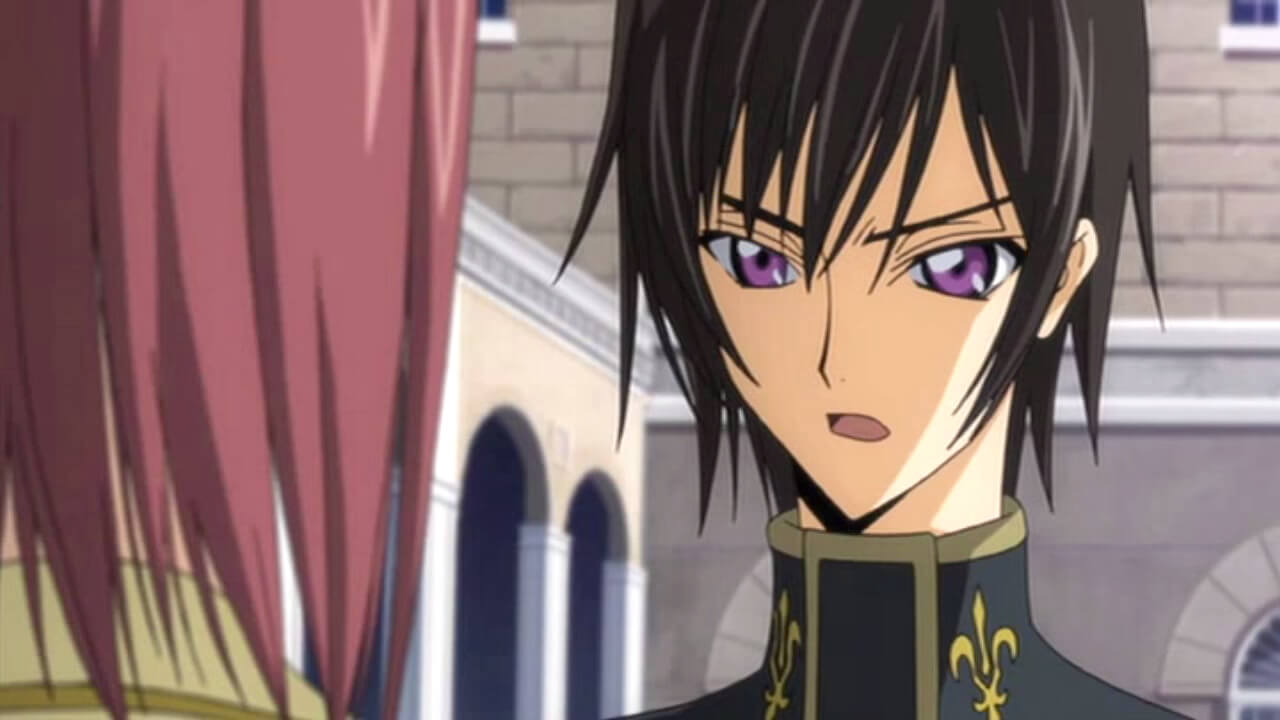
In the original, the bee has nothing to do with Lelouch at all – it’s just some random bee whose only narrative purpose is to momentarily break Kallen’s undercover act. But here it is the very basis of the dramatic conflict between Lelouch and Kallen, completely replacing their original ulterior motivations and secretive tension. It is apparent how the diversion here is rooted in catalysis, with one initial joke being the offset for a cause-effect-chain that is both elaborate and extremely different from the original. Furthermore, it is entirely achieved through the means of the medium; through dubbing, rearrangement of the visual content, and added diegetic sound (the buzzing of the bee), a whole alternate narrative is constructed.
This is essentially how the derivation of Code MENT at large operates; starting with a catalyzing point of diversion, and then executing the diversion through a medium-specific repurposing of the original material. While the core conceptual catalysis for the series is (as mentioned) the character alteration of Lelouch, its first major narrative catalysis occurs in episode two when Lelouch accidentally kills the prince. 9 From there on out it is one exercise in ridiculous idiocy after another. A strategic military battle turns into a clusterfuck of a bunch of morons flaying around. A mind game of secrets and double-crossings turns into mere surface-level interactions between simple-minded characters. Even the key plot element that is Lelouch’s power to momentarily control minds is radically undercut, as it is completely forgotten by him and never brought up for three whole episodes until C.C. reminds him about it – and even then he barely ever makes use of it.
The immediate relation to the original that we saw in YGO:TAS is not present here. Its derivation is not connected to the original, but cut away from it. As such, the status of the original is a lot more inconsequential; indeed it is only contextually significant insofar as the derivative work has used it as material for its own text. Here there is no speaking of a metatext overshadowing a narrative text, but simply one text replacing another.
Mashup: “Pirates and/or Ninjas” and “None Piece Episode 5 thru 7”
On May 6th 2011, PurpleEyesWTF uploaded the video “Pirates and/or Ninjas – Purple Eyes”. In contrast to Code MENT, it is a shorter, more unambitious standalone work seemingly released as just a ridiculous goof. Its nonsensical storyline is brief enough to be summarized in one paragraph:
The video begins in a Naruto setting. Hokage Hiruzen is in the middle of his meditation when he gets disturbed by Iruka, who has brought Luffy from One Piece with him. After some conflicting interactions between Luffy and Hiruzen (including the former breaking the latter’s crystal ball), Naruto enters the room. Luffy and Naruto have some confusing exchanges – at the increasing annoyance of Hiruzen – leading to Naruto telling Luffy that his “constant disassembly of dialogue is interfering with any rational plot development.” Luffy responds with “What the f**k is a plot?”, to which Naruto answers: “We must find out because you are a pirate and I am a ninja.” They proceed with charging up a beam between each other, resulting in Luffy puking up a knife which hits Lelouch in the shoulder. Yugi tells Lelouch to man up, but quickly gets to eat his words when several knives hit him as well. Hiruzen expresses a lack of understanding for what is going on. Luffy attempts to provide some context but gets cut off by Naruto, who subsequently gets threatened by an angered Luffy. Iruka decides to open his mouth, and Luffy pukes up a cat which on his command crashes into Iruka’s face and erases it. As a result, Luffy receives Hiruzen’s respect, as well as the start of a request for something. But before that “something” gets stated, Naruto cuts in with asking why Luffy hates him so much. Luffy retracts this by saying that “I don’t hate you, I am you.” Upon Naruto’s confusion, he elaborates with an analogy about women’s desire for yet ownership of shoes. After some silence Naruto attempts to piece this together with an interpretation relating to “imperialist China and-” but then gets cut off by Hiruzen puking up a cat in Luffy’s face. 10
Evidently, “Pirates and/or Ninjas” displays a very particular derivative approach: an elaboration on PurpleEyesWTFs previous diversional derivation that centrally embodies a mashup form. Characters from Naruto, One Piece, Code Geass and Yu Gi Oh! are pulled out of their respective narrative contexts and arranged into a chaotic crossover story. Furthermore, this story has not only a lack of plot structure, but makes an active effort to maintain this lack; whenever a character attempts to establish some form of narrative coherence, he gets cut off by another.
 Given these factors, the video can be seen as marking a shift in the abridge medium from “narrative” to “database”. In his book Otaku: Japan’s Database Animals, cultural critic Hiroki Azuma argues that otaku, as the poster children for Japanese postmodernity, are not interested in the consumption of narratives but of characters. These characters are furthermore assemblages of desirable components which are pulled out of a database and arranged by the consumer to fit his or her preferences. As such, the consumer is not simply a passive recipient of an original work, but an active producer of a derivative work through this form of assembling of preexisting material. 11 With “Pirates and/or Ninjas”, PurpleEyesWTF has similarly created a derivative work that is an assemblage of components from various parts of the anime “database” – an assemblage that, to top it off, disembodies a sense of narrative. This sense of assembling is present visually as well in the video’s peculiar form of editing, “copy-pasting” components from the original works and other places into what could be considered a collage.
Given these factors, the video can be seen as marking a shift in the abridge medium from “narrative” to “database”. In his book Otaku: Japan’s Database Animals, cultural critic Hiroki Azuma argues that otaku, as the poster children for Japanese postmodernity, are not interested in the consumption of narratives but of characters. These characters are furthermore assemblages of desirable components which are pulled out of a database and arranged by the consumer to fit his or her preferences. As such, the consumer is not simply a passive recipient of an original work, but an active producer of a derivative work through this form of assembling of preexisting material. 11 With “Pirates and/or Ninjas”, PurpleEyesWTF has similarly created a derivative work that is an assemblage of components from various parts of the anime “database” – an assemblage that, to top it off, disembodies a sense of narrative. This sense of assembling is present visually as well in the video’s peculiar form of editing, “copy-pasting” components from the original works and other places into what could be considered a collage.
But there’s more to it. Lelouch can from his voice be easily identified as the Lelouch of Code MENT. Additionally, Luffy is from his voice recognizable as the Luffy of PurpleEyesWTFs at the time newly started series None Piece, and Yugi is voiced by none other than Little Kuriboh, creating a connection to YGO:TAS. Hence, this isn’t simply a mashup of a collection of original works, but of previously established abridged series. It is a derivative work of derivative works, an assemblage pulling from an abridge database. At display here is thus the Baudrillardian concept of simulacrum that Azuma refers to; an entity that is neither an original nor a copy, replacing such a distinction in the postmodern commodity landscape. Just like Azuma recognizes a self-generative network of simulacra as permeating the derivative-based consumption-production of otaku, “Pirates and/or Ninjas” displays the same phenomenon vis-à-vis the abridge medium. 12
A variation on this independent status of the derivative can be seen in PurpleEyesWTFs second mashup video. Released on October 25th 2012 following the fourth episode of None Piece, “None Piece Episode 5 thru 7 – Purple Eyes” appears from its title to be a three-in-one-episode continuation of said series. Indeed, it begins much like any other None Piece episode, with its ensemble cast setting the tone through some comedic antics, followed by another tweaked variation on the One Piece opening. Immediately following the opening however, Death the Kid from Soul Eater enters the screen. In the middle of work he gets a phone call from the fellows of None Piece and Code MENT, who are having a rave party. Lelouch in particular has a ticking bomb in his hand as a way to provoke Death the Kid to show up. 13
“None Piece Episode 5 thru 7” is in many ways an elaboration of what “Pirates and/or Ninjas” established. It has a significantly longer run time of eleven minutes, a much larger cast of characters and a more extensive story that even follows a concrete plot structure. But above all, it is a foregrounding culmination of a narrative interconnection that runs through and ties together PurpleEyesWTFs body of work – including Code MENT, None Piece, and the shorter series Soul Whatever. The first indication of this interconnection occurs in episode ten of Code MENT, when Lelouch contacts his, as he claims, cousin Death the Kid via his computer. After that it can be seen in various places throughout the three titles both subtly and explicitly. YouTube user Brawlnanigans edited together all of it into one continuous video, which can be seen here. 14
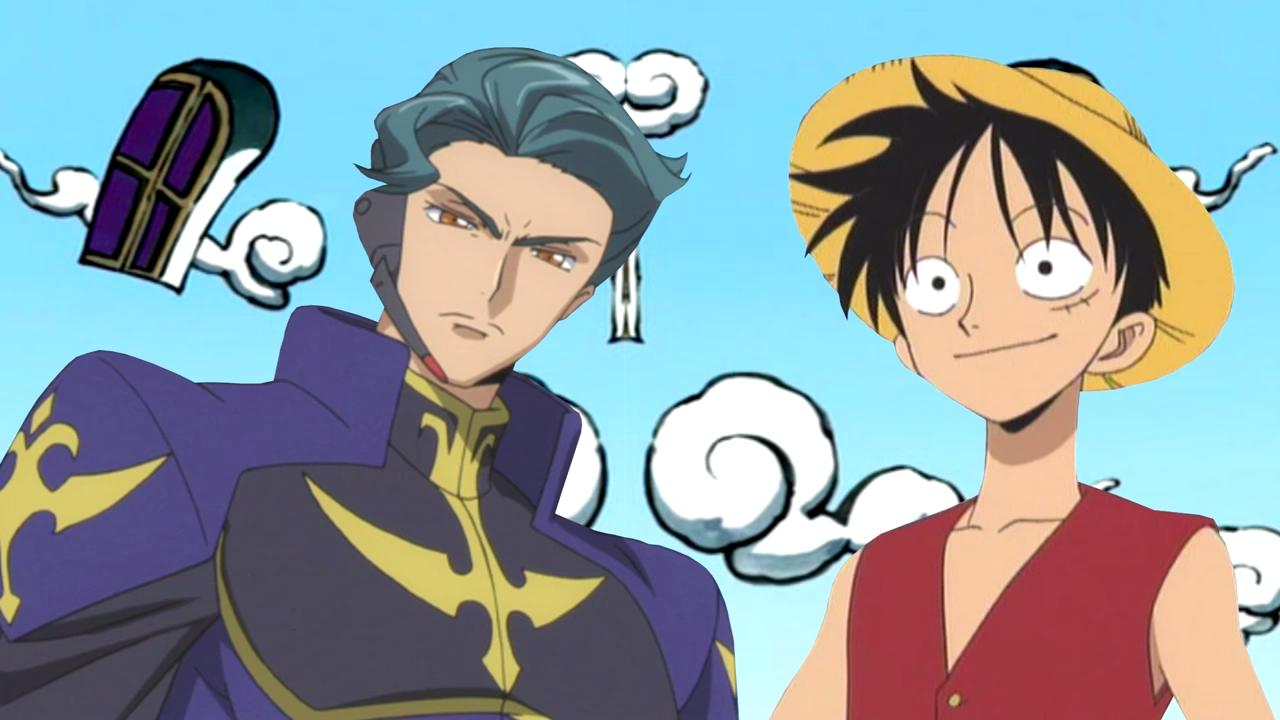
This interconnected narrative indicates that PurpleEyesWTFs catalog is more than just a collection of abridge videos and series; it is a fictional universe. While the presence of this universe only extends to a sub-element throughout the three series, with “None Piece Episode 5 thru 7” it is surfaced and centralized as a main story. Whereas “Pirates and/or Ninjas” is a mashup pulling from an abridge database, this video is a representative of the mashup embodied by PurpleEyesWTFs abridge output at large. Both videos undermine the status of the original to the point of pretty much nonexistence; the former cuts away from the original through the embodiment of simulacrum, while the latter overshadows it with the prevalence of its fictional universe.
All in all, the mashup form marks the final stage in the increasingly weakened relation between derivative and original in the abridge medium. YGO:TAS was connected to the original via its metatextuality, Code MENT was disconnected from the original due to its independent alteration, and now “Pirates and/or Ninjas” and “None Piece Episode 5 thru 7” throw away the original altogether.
Abridged series may at its core be no more than comedic anime parodies. But depending on their approaches to the medium, they can display some very interesting derivative qualities. They can be subversive meta-commentaries on the source material. They can divert away from the material by embodying an alternate version of it. They can even be self-generative mashups that undermine the very existence of the material as well as the concept of original-copy itself. The four abridge titles discussed in this article demonstrate these different ways in which abridge series may operate as derivative media.
Go to Abridged Series for direct viewing access to titles such as the ones mentioned here, plus updates, watch lists and more.
Works Cited
- ericg, “Abridged Series: A Short History”, The Artifice, 2016, <https://the-artifice.com/abridged-series-history/> ↩
- ericg, “Abridged Series”, 2016 ↩
- Little Kuriboh, “YGOTAS Episode 1 – Pilot – LittleKuriboh”, Yu Gi Oh! The Abridged Series, YouTube, 2009, <https://youtu.be/-32NGYLqwAQ> ↩
- Little Kuriboh, “YGOTAS Episode 3 – My Cards Will Go On – LittleKuriboh”, Yu Gi Oh! The Abridged Series, YouTube, 2009, <https://youtu.be/fGAl9__U8Uk> ↩
- Little Kuriboh, “YGOTAS Episode 7 – Cliffhanger – LittleKuriboh”, Yu Gi Oh! The Abridged Series, YouTube, 2009, <https://youtu.be/jBeDOvxatKw> ↩
- ericg, “Abridged Series”, 2016 ↩
- PurpleEyesWTF, “Code MENT Episode 1 – Purple Eyes”, Code MENT, YouTube, 2010, <https://youtu.be/miP21jnj3RU> ↩
- PurpleEyesWTF, “Code MENT Episode 3 – Purple Eyes”, Code MENT, YouTube, 2010, <https://youtu.be/fGRwH342LlU> ↩
- PurpleEyesWTF, “Code MENT Episode 3”, 2010 ↩
- PurpleEyesWTF, “Pirates and/or Ninjas – Purple Eyes”, YouTube, 2011, <https://youtu.be/Hay33ndHjwk> ↩
- Azuma, Hiroki, Otaku: Japan’s Database Animals, London: University of Minnesota Press, 2009 (2001) ↩
- Azuma, Otaku, 25-26, 2009 ↩
- PurpleEyesWTF, “None Piece Episode 5 thru 7 – Purple Eyes”, YouTube, 2012, <https://youtu.be/YME40ObCkVI> ↩
- Brawlnanigans, “Code Soul None Piece Whatever MENT v2 (PurpleEyesWTF)”, YouTube, 2017, <https://youtu.be/yTQOgGvJkhE> ↩
What do you think? Leave a comment.
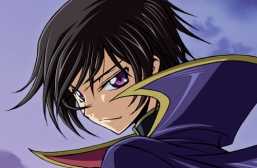
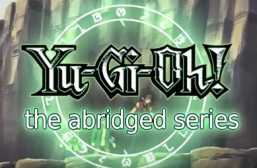
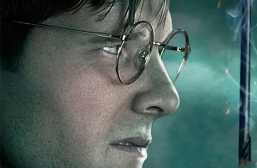


I tried getting my wife into DBZ and even with Kai (which is essentially slimfast DBZ) she just couldn’t get into it due to the slower pacing and feeling like nothing was being accomplished as episodes would go by (understandable). We gave up on actual DBZ around Freeza’s third form and I decided to show her DBZA instead and now she actually cares about the series and understands pretty much everything about DBZ just because of an alternate presentation of the material. I think that’s really cool and a testament to the quality of the series.
I await DBZ abridged with the same amount of excitement as dragon ball super. I can appreciate the great story (power level buildup and payoff cycles) of the cell saga as just an improved version with better voice actors, editing, and the long running jokes.
My interest is peaked, thanks. I’ve been meaning to check out the Jojo’s Bizarre Adventure Abridged.
Its not actually an abridged series but you should look into the English dub of Ghost Stories. Its an anime that the voice actors were given a bare bones plot synopsis and told to go wild with it to make a generic horror/adventure anime sell. Its pretty easy to find a best of jokes reel on youtube.
Forgot to mention that it is pretty short too, only 20 half hour episodes so its pretty easy to finish.
Great comment. It’s not an abridged series by any means, but it may as well be one…
Ghost Stories and Bobobo dubbed! Basically official abridged series. Moreso Ghost Stories, but Bobobo plays out like one.
For newcomers to this style of media, I recommend EVAbridged. It is short but pretty good abridged series.
I recommend AB series of Free. Its so funny if you have seen the anime. I was cracking up.
THIS. The Free! Abridged (known as 50% off) by Octopimp is pretty funny, and a lot of people who haven’t seen Free! or have interest in it still really enjoy the abridged series.
It is the epitome of online art given its heavily derivative nature.
I love abridged series, BUT I have grown to hate a lot of it’s fans. The jokes that poke fun at the series are generally pretty good and I love the changes to the story for the most part, but these elements attract the worst of the fandom making discussion a real pain when the abridged series comes up as a “fixed” version of their “adapted” source.
CodeMent was pretty damn good. You should watch Code Geass beforehand, though.
If you already seen Code MENT, then you probably have already seen None Piece, featuring Sean Connery made out of rubber, and Soul Whatever, which “connects” MENT and None together alongside that NullMetal and Danganropa cameos.
Enjoyed reading this but from what I have been exposed to, I find Abridged series to be overrated and unfunny, especially the DBZ Abridged.
SAO Abridged does its job better than DBZ Abridged, in that instead of complimenting and rivaling the source material, it superannuates it by being objectively better. I highly recommend it.
The Pokemon Abridged was pretty great, and nobody seems to mention it. I highly recommend it.
I’m kinda a fan of the old Berserk abridged. It’s not quite as funny as SAOAbridged or 50% of was, but the ending is really therapeutic if you’ve watched the series.
It’s incredibly easy to get into abridging! If you have basic knowledge of cutting segments of video and placing audio over it then that’s half the job done right there. It just takes dedication to write it and get VA’s to stay with the project without dropping out. The biggest killer of abridged series is lack of dedication among creators. So stick with it!
Great writing about my (relativly new) fav art form. My favorite 3 abridged series (Not particularly done and/or continuing):
1. Dbz abridged
2. Hellsing Abridged
3. SAO abridged
The DBZ one used to be great. These days though it seems like the writers aren’t even trying. YGO abridged also went to shit lately. It still has jokes but they’re all delivered horribly compared to how they used to be. In the new episodes, all the characters seem to stop to explain every joke.
Most parodies are either too basic, try too hard to be edgy or or follow a specific trend.
LittleKuriboh did with Yu-Gi-Oh! what abridged actually means, to shorten while keeping the main topic the topic of interest. Other Abridged series I’ve seen recently deviate from that, and are now just cheesy one liners over the original show.
Yeah YGOTAS is the only abridged series I can stand.
Anything PurpleeyesWTF touches is gold.
Dragonball Z was a huge part of my childhood. Now, over 10 years after I first became obsessed with it as a kid, new series and a fantastic abridged series are running as we speak, with new games coming out all the time.
SAO abridged is the actual anime for me, better character development and pacing and well just better overall
Another abridged series that also puts a whole lot of polish and professionalism into the art is the DC Universe Abridged, formerly just Young Justice Abridged. Its funny, well-made and have even made a complete continuity/time-line via abridging the animated movies. Under-appreciated, but high quality.
In the beginning I dislike abridged series, particularly for swearing, but I grow numb from the passing years. Then it did tickle me.
Great piece. It is funny how Sword Art Online Abridged is generally thought of as much better than the original.
Kirito is a way more interesting character in the Abridged series.
I think an interesting entry into the subversion category would be Sword Art Online Abridged. Series like Yu-gi-oh Abridged and Dragonball Abridged have no qualms about lambasting their source material, but their jokes and criticism always come from a place of love for the original. Sword Art Online Abridged, on the other hand, comes from a place of distain for the original. This causes SAO Abridged’s comedy to have a harsher tone that is not only hilarious but also unique from other abridged series.
I think one of the major reasons why abridging has evolved so much is due to creators being more active in the editing. This is particularly evident in YGO:TAS.
The original episodes were extremely short and had minimal editing. The writing is similar to an anime script adapter: a script is written within the constraints of the animation. Later episodes regularly run over 10 minutes and the new scripts could never fit in the original animation, so it’s edited to accommodate the script instead of the other way around.
Those creative risks and liberties helped evolve abridged series from fan parodies to what you’ve written here.
I personally am not a fan of abridged series (probably b/c I take myself and anime too seriously) but this article was really interesting and maybe I’ll consider getting into one of the series listed…
*Kanye shrug*
I recommend checking out Megami33’s Sailor Moon Abridged(SMA). It was short lived, not even completing its second season, but it was effective and funny. It followed the YGO:TAS derivation of a metatext that both told the story as it mocked it. They were very influenced by LittleKuriboh, often employing the same “Seriously, they said this.” tactic by pointing out the ludicrous aspects of the original series.
SMA wasn’t as influential as YGO:TAS or DBZA, but it was popular enough to allow Megami33 to join the DBZA cast as Bulma. They even add in a reference to Megami33 playing Sailor Moon in DBZA, playing a “Lunar Expert” in a news broadcast.
My ex wasn’t interested in anime in the slightest, until they were exposed to an abridged series. He couldn’t take the, often, insane concepts of an anime plot, but presented with a self-aware sense of humour, he was suddenly interested. It might be a sign of a shift in society in the face of the absurd.
There are some YouTube essays that have been written about why viewership of the news being delivered by comedians, such as Stephen Colbert, Seth Meyers or Samantha Bee, is greater than serious news networks. Some are theorizing that we trust someone telling us about something ridiculous while identifying that it is ridiculous, rather than someone telling us the same thing but taking it seriously. That their inability to call out something that is absurd, may cause the younger audience to be hesitant to rely on them for facts.
An interesting read. Code MENT’s appeal for me really was its diversion from the original material, or I guess, its butchering of it. What really got to me was how, in spite of all the random references, non sequiturs and backwards logic, it still managed some level of narrative continuity.
I think the most true-to-canon abridged series I’d ever watched was Baccano! Abridged! by JelloApocalypse. Only minor deviations from canon plot. Unfortunately copyright strikes took it down, but by god the voice acting did a great job mirroring the actual English dub, or at least the accents.
Fascinating article! It’s nice to see something like silly internet parodies be analyzed through a more critical lens. Come to think of it, depending on how popular a derivative series may be could classify it within the realm of transmedia story-telling in the same regards of how fan fiction is treated in the academic realm.